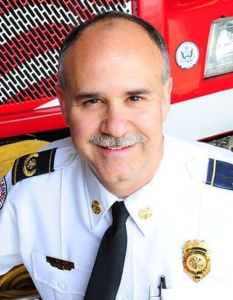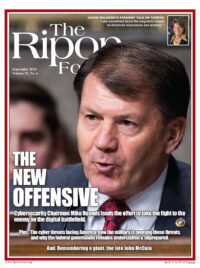
The horrendous attacks on the U.S. on September 11, 2001 highlighted the need for better communications for the nation’s police, fire, and EMS responders. Prior to 2001, the ability to communicate over commercial wireless carriers would routinely be unavailable during major incidents, large scale events and even some holidays — times when first responders need it the most.
The 9/11 Commission Report published in 2004 included a recommendation that: “Congress should support pending legislation which provides for expedited and increased assignment of radio spectrum for public safety purposes. Furthermore, high-risk urban areas, such as New York City and Washington, D.C., should establish signal corps units to ensure communications connectivity between and among civilian authorities, local first responders, and the National Guard. Federal funding of such units should be given high priority by Congress.”
Two years later, Morgan O’Brien, the former CEO of Nextel, met with a number of public safety representatives and proposed a concept of dedicated broadband spectrum for public safety. This concept would carve out 20 MHz of 700 MHz spectrum (known at the time as “D” Block) that would be dedicated to public safety and would provide priority and preemption to ensure that first responders could communicate 365 days/year and 24/7 regardless of the traffic congestion on the wireless network.
Prior to 2001, the ability to communicate over commercial wireless carriers would routinely be unavailable during major incidents, large scale events and even some holidays — times when first responders need it the most.
Over the next five years, there would be numerous meetings with commercial wireless carriers and legislators, along with a failed/flawed spectrum auction. Following the failed spectrum auction, in 2010, a meeting was held between public safety officials and the commercial wireless carriers in Reston, Virginia. In this meeting — which I attended as the chair of the SAFECOM Executive Committee — public safety officials specifically asked the carriers if they would provide priority and preemption. The answer from all of the commercial wireless carriers was a resounding, “NO”.
In response, the next two years saw an unprecedented and united front emerge among all of the national public safety organizations (police, sheriffs, fire service, and EMS) in support of a nationwide public safety broadband network. The momentum continued to grow as the Big 7 national organizations (Council of State Governments, National Governors Association, National Conference of State Legislatures, National League of Cities, United States Conference of Mayors, National Association of Counties, and the International City/County Management Association) supported the 20 MHz of spectrum and the development of a NPSBN.
In 2012, Congress passed the Middle Class Tax Relief and Job Creation Act, which created the First Responder Network Authority (FirstNet) as an independent authority within NTIA, to provide emergency responders with the first high-speed, nationwide broadband network dedicated to public safety. As part of this legislation, Congress purposely defined FirstNet’s network components, stating: “The nationwide public safety broadband network shall be based on a single, national network architecture that evolves with technological advances…” [1]
In 2017, FirstNet awarded a 25-year contract and entered into a public-private partnership with AT&T (the only wireless carrier to bid) to build the network. While the legislation specified a dedicated 20 MHz of spectrum (Band 14), AT&T did something that would prove to be innovative and beneficial to public safety by providing priority and preemption on not only Band 14, but over AT&T’s entire nationwide LTE spectrum. This resulted in the immediate access to priority and preemption for public safety on current devices as well as existing and future Band 14 enabled devices.
The good news is that America finally has a dedicated network that will allow first responders to communicate with each other during times of a disaster or emergency.
After Virginia became the first state to opt-in to the network, the Fairfax County Fire Department became the first agency on FirstNet. Presently, all 50 states and 6 territories have opted in to FirstNet, and thousands of public safety agencies are utilizing the network with many more in transition. Success stories are already being seen. Fairfax County transitioned to FirstNet and immediately took advantage of priority and preemption, utilized enhanced push to talk (ePTT) and interfaced with their land mobile radio system and created a larger coverage footprint through smart phones and tablets. This enabled some non-priority radios to be replaced by smart phones, reducing capital costs presently and in the future.
Brazos County (TX) Sheriff’s Department became the first local agency in Texas to deploy FirstNet. Brazos Sheriff Chris Kirk described how his department is now able to do things they never imagined, like viewing live streaming video from any one of his 61 patrol cars. They used this streaming video for situational awareness during Hurricane Harvey, during a tornado, and during large events. Both Fairfax County and Brazos County have also reported that during large scale events with a large attendance of people that they were previously unable to make mobile calls and unable to stream video. Today, they are able to communicate and stream video over FirstNet.
The importance of having a single network like FirstNet that is dedicated to public safety cannot be overstated, and that has been reinforced by a recent incident involving the Santa Clara County Fire Department. The Department had an unlimited data plan with Verizon. During the major wild land fires which broke out in the area earlier this year, the Department experienced heavy throttling of their service. “This throttling has had a significant impact on our ability to provide emergency services,” Santa Clara County Fire Chief Anthony Bowden wrote. Verizon apologized for this incident, saying it made a customer service error. The company has now lifted data restrictions for first responders on the West Coast. But make no mistake — error or not, the restrictions should never have been put in place.
The good news is that America finally has a dedicated network that will allow first responders to communicate with each other during times of a disaster or emergency. FirstNet is THE Nationwide Public Safety Broadband Network requested by and designed for public safety. FirstNet’s mission is to serve America’s first responders when and where they need it the most, anytime and all of the time.
It should not have taken 17 years to put this kind of network in place. But as we mark another anniversary of 9/11, let us be thankful that a lesson from that awful day has finally been learned, and lives will be saved as a result.
Charles Werner is a 44-year veteran of public safety. He is fire chief emeritus of the Charlottesville, VA, Fire Department, and recently served as senior advisor and acting deputy state coordinator to the Virginia Department of Emergency Management. Chief Werner also served on the Department of Homeland Security SAFECOM Executive Committee, the National Public Safety Telecommunications Council and on the first FirstNet Public Safety Advisory Committee.
_______________________________________________________________________
[1] Similar language to the final FirstNet legislation was also provided in a white paper entitled, “Verizon Recommendation to FirstNet.”




